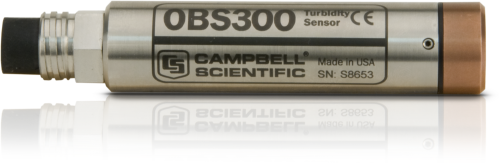This product is no longer available and has been replaced by: ClariVue 10.

| 利用できるサービス | |
|---|---|
| 修理 | 非対応 |
| キャリブレーション | 非対応 |
| フリーサポート | 対応 |
概要
The OBS300 is a submersible turbidity probe that has downward-facing optics. It uses OBS technology to measure suspended solids and turbidity for applications ranging from water quality in freshwater rivers and streams to sediment transport and dredge monitoring. Campbell Scientific data loggers measure the OBS300 probe's output and calculate turbidity.
続きを読む利点と特徴
- Downward-facing optics avoid obstructions around the sides of the probe
- Measures suspended solids and turbidity for up to 4000 NTUs
- Provides a compact, low-power probe that is field proven
- Stainless-steel body allows use down to 500 m in fresh water
- Compatible with most Campbell Scientific data loggers
- Titanium body allows use down to 1500 m in fresh or salt water
- Accurate and rugged
- Fitted with MCBH-5-FS, wet-pluggable connector—multiple mating cable length options available
- Offers an optional five-point sedimentation calibration for better measurements (see Ordering Info on the web page)
イメージ



詳細
The OBS300 uses its downward-facing optics to emit a near-infrared light into the water. It then measures the light that bounces back from the water’s suspended particles.
If an obstruction is in the emitted light’s range, the light will scatter back and the turbidity reading will be too high. This probe's downward-facing optics avoid obstructions around the sides of the probe. The OBS-3+ is available for locations that have obstructions above and below the probe. (OBS® is a registered trademark of Campbell Scientific.)
仕様
| Range |
|
| Maximum Submersion Depth |
|
| Maximum Concentration Range |
|
| Concentration Accuracy |
|
| Operating Temperature Range | 0° to 40°C |
| Drift over Time | < 2% per year |
| Maximum Data Rate | 10 Hz |
| Minimum Warm-up Time | 2 s |
| Infrared Wavelength | 850 nm ±5 nm |
| Daylight Rejection | -28 dB (re: 48 mW/cm-2) |
| Optical Power | 2000 µW |
| Turbidity Accuracy | 2% of reading or 0.5 NTU (whichever is larger) |
| Housing Material | 316 stainless steel or titanium |
| Connector | MCBH-5-FS, wet-pluggable |
| Diameter | 2.5 cm (0.98 in.) |
| Height | 13.1 cm (5.15 in.) |
| Weight | 181.4 g (0.4 lb) |
-2.5 Output Option |
|
| Output Voltage | 0 to 2.5 V (over selected NTU range) |
| Supply Voltage | 5 to 15 Vdc |
| Current Drain | 15 mA |
-5 Output Option |
|
| Output Voltage | 0 to 5 V (over selected NTU range) |
| Supply Voltage | 5 to 15 Vdc |
| Current Drain | 15 mA |
-20 Output Option |
|
| Output Voltage | 4 to 20 mA (over selected NTU range) |
| Supply Voltage | 9 to 15 Vdc |
| Current Drain | 45 mA |
互換性
注意: 以下は代表的な互換性情報を示しています。互換性のある製品や互換性のない製品をすべて網羅したリストではありません。
ドキュメント
テクニカルペーパー
- OBS and Turbidity Sensors Basics (2Q-P)
- OBS: Effects of Light Absorption and Scattering in Water Samples on Measurements
- OBS Sensors: Light Sources and Photodetectors
- OBS: Effects of Suspended Solids Concentration (SSC)
- OBS Measurements: Effects of Sediment Size
- OBS Measurements: Effects of Sediment Color
- OBS Measurements: Effects of Water Color
- OBS: Effects of Bubbles
- OBS Sensor: Effects of Fouling on the Lens
- OBS Sensors: Sediment Calibration
- OBS Sensors: Turbidity Calibration
- OBS: Comparison of Suspended Solids Concentration (SSC) and Turbidity
よくある質問
OBS300に関するよくある質問の数: 16
すべて展開すべて折りたたむ
-
Typically, users use a clamp (a hose clamp, for example) to fasten the sensor to a permanent structure in the water so that the optics are orientated toward the open water.
-
Yes. The OBS300 is not harmed by being dry. The optics, however, need to be cleaned of any dust or contamination before the measurements are resumed.
-
This has not been tested; however, it is likely that, as the sensor moves through the water, disturbances or bubbles are created that could distort the turbidity measurements.
-
The beam divergence angle of the sensor is 42°. (Within this 42° cone, 95% of the beam power is contained.)
-
These devices employ optical backscatter to measure light absorption and should produce comparable data, but variation is likely between sensors.
-
The accuracy is 0.5 NTU or 2% of reading.
-
Sensors are calibrated at the factory for measurements up to 4,000 NTUs, if requested at the time of order. Sensor ranges cannot be adjusted outside the factory.
-
The following are some suggestions:
- Keep the optics clean.
- Site-specific field calibration may be necessary for the best performance.
- Prevent the sensor from freezing.
-
The OBS-3+ and the OBS300 are essentially the same sensor but with differing optic placement. The OBS-3+ has sideways-facing optics, whereas the OBS300 has downward-facing optics.
-
Campbell Scientific does not offer a display that can be attached directly to the sensor; however, the data logger used to capture and record the data may have a display.
記事とプレスリリース
Privacy Policy Update
We've updated our privacy policy. 詳細はこちら
Cookie Consent
Update your cookie preferences. クッキーの設定を更新する